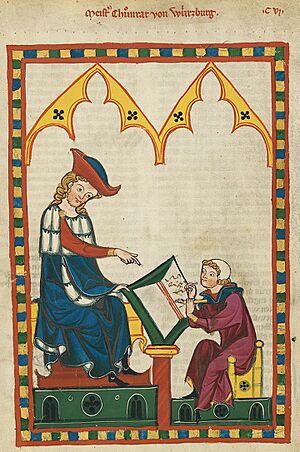Konrad von Würzburg facts for kids

Konrad von Würzburg (born around 1220-1230, died August 31, 1287) was a very important German poet. He lived in the 13th century. Many people think he was the best German poet of his time.
Contents
Who Was Konrad von Würzburg?
Konrad came from a town called Würzburg in Germany. We know quite a lot about his life, which is unusual for poets from the Middle Ages. He lived in different cities. He spent some time in Strasbourg. Later, he moved to Basel, where he even owned a house. We also know the names of his wife and daughters. He passed away in Basel in 1287.
Unlike many other poets back then, Konrad was not from a noble family. He was a regular person. He admired another famous poet named Gottfried von Strassburg. Konrad wrote many different kinds of stories and poems. His writing was usually very good. It did not have the problems that some other German poetry had during the 13th century.
Konrad's Writing Style
Konrad's writing style was serious and respectful. Sometimes, his sentences were a bit long. He liked to change the rhythm of his poems, just like Gottfried von Strassburg did. His poems always followed the rules of poetry. His stories were also clean and proper. They did not have rude parts, which was common for other popular poets at the time.
Konrad often wrote about mysticism and allegory. Mysticism is about a deep spiritual connection. Allegory is when a story has a hidden meaning. Even with these themes, his works were still true poetry.
Famous Works by Konrad
Konrad wrote many different kinds of stories and poems. Here are some of his well-known works:
- Legends: He wrote stories about Christian saints. These include Alexius, Silvester, and Pantaleon. They showed important Christian values.
- Der Welt Lohn: This was a teaching story. It was about a common idea called Frau Welt (Lady World). She looked beautiful from the front. But from behind, she was ugly and unpleasant. This story taught a lesson about appearances.
- Die goldene Schmiede: This poem praised the Virgin Mary. It was like a song of honor for her.
- Klage der Kunst: This was an allegorical poem. It defended the art of poetry itself.
- Herzmaere: This is a sad story about a knight's heart. A knight loved a married noblewoman. Her husband was very jealous. The knight died on a trip to the Holy Land. His helper tried to take the knight's heart to his lover. But the husband found out. He had the heart cooked and gave it to his wife to eat. When she learned the truth, she died of sadness.
Konrad's Longer Stories
Konrad also wrote two very long epic poems. An epic is a long story about heroes and adventures.
- Der trojanische Krieg: This poem had more than 40,000 lines! It was about the Trojan War. But Konrad never finished it.
- Partenopier und Meliur: This was another long epic poem. Both of these long stories were based on older French stories.
Shorter Poems and Romances
Konrad was especially good at writing shorter love stories in verse. These are called romances. Some of his best shorter works include:
- Engelhart und Engeltrut
- Kaiser Otto
- Das Herzemaere
Das Herzemaere is one of the best poems of its kind from the Middle Ages. A later writer, Ludwig Uhland, made a similar story famous called Kastellan von Coucy.
Where to Find Konrad's Works
There is no single book that has all of Konrad's writings. But many of his works have been published separately over the years:
- Der trojanische Krieg was edited by A von Keller in 1858.
- Partonopier und Meliur was edited by K Bartsch in 1871.
- Die goldene Schniede and Silvester were edited by W Grimm in 1840 and 1841.
- Alexius was edited by HF Massmann in 1843 and R Haczynski in 1898.
- Der Welt Lohn was edited by F Roth in 1843.
- Engelhart und Engeltrut was edited by Moritz Haupt in 1844.
- Klage der Kunst was edited by E Joseph in 1885.
You can find the shorter poems, Otto and Herzemaere, in a collection called Erzählungen und Schwänke des Mittelalters. This book was edited by H Lambel in 1883. Later, German translations of Konrad's most popular poems were published by K Pannier and H Kruger between 1879 and 1891.

